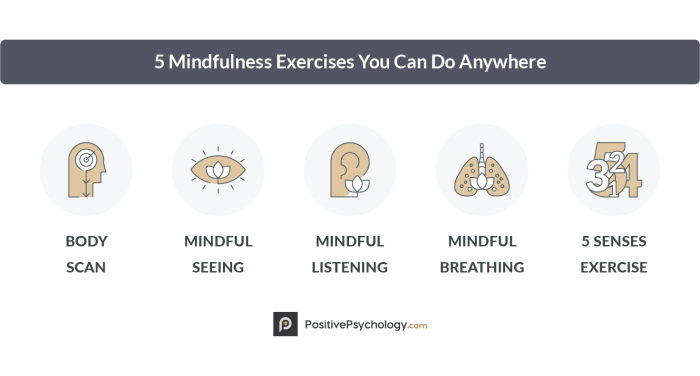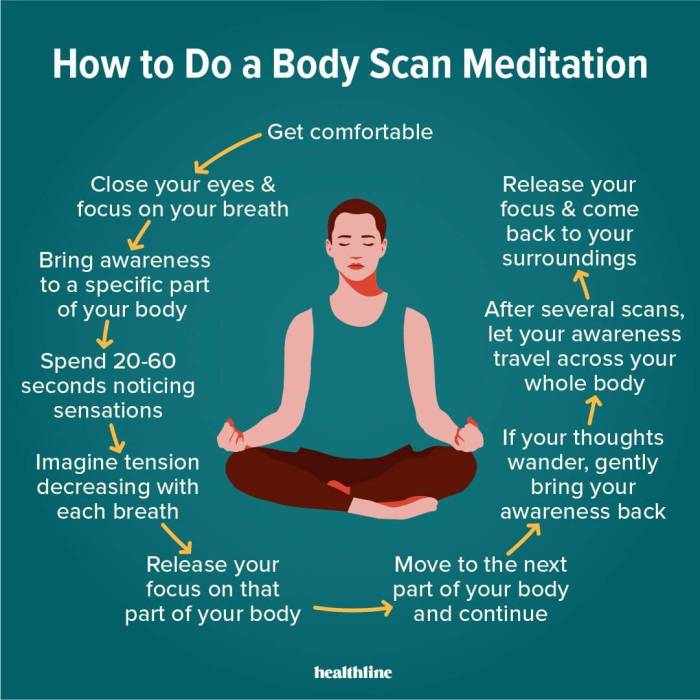Embark on a journey of self-discovery with 12 Meditation Exercises for Mental Clarity, diving into techniques that will sharpen your focus and bring peace to your mind. From breathing exercises to visualization techniques, this guide will help you achieve mental clarity like never before.
Explore the power of mindfulness, body scan meditation, and chanting practices to enhance your overall well-being. Whether you’re a beginner or an experienced meditator, these exercises will guide you towards a more focused and clear state of mind.
Introduction to Meditation Exercises

Meditation exercises are techniques that involve focusing the mind and eliminating distractions to achieve a state of mental clarity and inner peace. These exercises can include deep breathing, mindfulness, visualization, and mantra repetition.
There are numerous benefits of meditation for mental clarity, including reduced stress, improved concentration, enhanced self-awareness, and a sense of calmness. By practicing meditation regularly, individuals can sharpen their cognitive abilities, increase emotional resilience, and promote overall well-being.
Importance of Mental Clarity for Overall Well-being
- Enhanced Decision Making: Mental clarity allows individuals to think more clearly and make informed decisions without being clouded by emotions or distractions.
- Reduced Anxiety and Stress: By achieving mental clarity through meditation, individuals can alleviate anxiety and stress, leading to a more balanced and peaceful state of mind.
- Improved Relationships: Clarity of mind helps individuals communicate effectively, empathize with others, and maintain healthy relationships.
- Boosted Productivity: When the mind is clear and focused, productivity levels increase as individuals can prioritize tasks and work efficiently.
Breathing Techniques
Breathing exercises play a crucial role in promoting mental clarity and overall well-being. Deep breathing techniques can help calm the mind, reduce stress, and improve focus and concentration.
Diaphragmatic Breathing Exercise
One effective breathing exercise for mental clarity is diaphragmatic breathing, also known as belly breathing. Here’s a step-by-step guide to practice this calming technique:
- Sit or lie down in a comfortable position with your hands resting on your abdomen.
- Inhale deeply through your nose, allowing your belly to expand as you fill your lungs with air.
- Exhale slowly and completely through your mouth, feeling your belly contract as you release the air.
- Continue this deep breathing pattern, focusing on the rise and fall of your abdomen with each breath.
- Repeat this exercise for several minutes, gradually increasing the duration as you become more comfortable with the technique.
Diaphragmatic breathing can help reduce feelings of anxiety and promote a sense of calm and mental clarity.
Alternate Nostril Breathing Technique
Another beneficial breathing exercise for mental clarity is the alternate nostril breathing technique, also known as Nadi Shodhana in yoga. Here’s how to practice this technique:
- Sit comfortably with your spine straight and your left hand resting on your left knee.
- Use your right thumb to close your right nostril and inhale deeply through your left nostril.
- Close your left nostril with your right ring finger, release your right nostril, and exhale completely.
- Inhale through your right nostril, close it with your right thumb, release your left nostril, and exhale.
- Continue this pattern, alternating nostrils with each breath, focusing on the flow of air and maintaining a steady rhythm.
Alternate nostril breathing can help balance the mind, improve mental focus, and alleviate stress and tension.
Mindfulness Meditation
Mindfulness is the practice of intentionally focusing on the present moment without judgment. It plays a crucial role in mental clarity by helping individuals become more aware of their thoughts and emotions, allowing them to respond to situations with greater clarity and calmness.
Techniques for Beginners
- Start by finding a quiet and comfortable place to sit or lie down.
- Close your eyes and bring your attention to your breath, focusing on the sensation of each inhale and exhale.
- Notice any thoughts, feelings, or sensations that arise without getting attached to them, simply observing them as they come and go.
- If your mind starts to wander, gently bring your focus back to your breath without judgment.
- Practice this for a few minutes each day, gradually increasing the duration as you become more comfortable.
Benefits of Mindfulness in Focusing the Mind
- Mindfulness meditation helps improve concentration and attention span by training the mind to stay present and focused.
- It reduces stress and anxiety, allowing individuals to approach challenges with a clear and calm mindset.
- By cultivating awareness of the present moment, mindfulness enables individuals to let go of distractions and negative thoughts, enhancing mental clarity and cognitive function.
- Regular practice of mindfulness meditation can lead to greater emotional resilience and overall well-being.
Visualization Exercises

Visualization is a powerful technique used in meditation to enhance mental clarity. By creating vivid mental images, individuals can focus their mind, reduce stress, and improve overall well-being.
Visualizing a Peaceful Place
One effective visualization exercise for mental clarity is to imagine yourself in a peaceful place. Close your eyes, take deep breaths, and visualize a serene environment such as a beach, forest, or mountain top. Engage your senses by imagining the sights, sounds, and smells of this peaceful place.
Visualizing a Clear Mind
Another visualization exercise involves picturing your mind as a clear blue sky, free from clouds or distractions. As you breathe deeply, visualize any negative or cluttered thoughts dissipating like clouds, leaving behind a clear and calm mind.
Visualizing Positive Outcomes
Visualizing positive outcomes can have a profound impact on mental well-being. By imagining successful scenarios, individuals can boost their confidence, reduce anxiety, and cultivate a positive mindset. Visualize yourself achieving your goals, overcoming challenges, and embracing happiness and success.
Body Scan Meditation

Body scan meditation is a mindfulness practice that involves focusing on different parts of the body to promote relaxation, release tension, and increase awareness of physical sensations.
Benefits of Body Scan Meditation
- Helps in promoting relaxation and reducing stress
- Increases body awareness and mindfulness
- Improves sleep quality and overall well-being
- Enhances mental clarity and focus
Step-by-Step Guide to Perform Body Scan Meditation
- Find a comfortable and quiet place to sit or lie down.
- Close your eyes and take a few deep breaths to relax.
- Start by bringing your attention to your toes, focusing on any sensations you feel there.
- Slowly move your attention up through each part of your body, from your feet to your head, noticing any tension or discomfort.
- As you scan each body part, try to release any tension or tightness you may feel by breathing into that area.
- Continue this process until you have scanned and released tension from every part of your body.
- Take a few more deep breaths and slowly open your eyes when you are ready.
How Body Scan Meditation Helps in Releasing Tension and Promoting Mental Clarity
Body scan meditation helps in releasing tension by bringing awareness to areas of the body that may be holding stress or discomfort. By focusing on each body part and consciously relaxing it, you can release physical tension and promote a sense of relaxation throughout your body. This practice can also help in promoting mental clarity by allowing you to become more present and focused, reducing distractions and calming the mind.
Walking Meditation
Walking meditation is a mindfulness practice that involves walking slowly and intentionally, focusing on each step and being fully present in the moment. It combines the physical benefits of walking with the mental clarity and relaxation of traditional meditation techniques.
Benefits of Walking Meditation
- Improves focus and concentration
- Reduces stress and anxiety
- Increases awareness of body and surroundings
- Promotes relaxation and mindfulness
Tips for Practicing Walking Meditation Effectively
- Choose a quiet and safe place to walk, preferably in nature or a peaceful environment.
- Start by standing still and taking a few deep breaths to center yourself before beginning to walk.
- Focus on the sensation of each step, the movement of your body, and the sounds around you.
- If your mind starts to wander, gently bring your attention back to the act of walking.
- Set a timer or decide on a specific route to walk for a certain amount of time to maintain consistency.
Chanting and Mantra Meditation
Chanting and mantra meditation involve the repetition of specific words, phrases, or sounds to focus the mind and achieve a state of mental clarity.
Benefits of Chanting or Repeating Mantras
- Chanting or repeating a mantra can help in achieving mental clarity by calming the mind and reducing distractions.
- It can create a sense of inner peace and relaxation, leading to improved concentration and focus.
- Mantras can also have a calming effect on the nervous system, reducing stress and anxiety.
- By focusing on the sound and vibration of the chant or mantra, practitioners can cultivate mindfulness and presence in the moment.
Popular Mantras or Chants for Meditation
“Om”
This universal mantra is often chanted to bring a sense of peace and connection to the present moment.
“So Hum”
Translating to “I am that,” this mantra can help practitioners realize their connection to the universe.
“Om Mani Padme Hum”
A Tibetan Buddhist mantra that invokes the blessings of compassion and wisdom.
“Sat Nam”
Meaning “truth is my identity,” this mantra is used in Kundalini yoga for self-empowerment.
Loving-Kindness Meditation
Loving-Kindness Meditation, also known as Metta Bhavana, is a meditation practice that involves cultivating feelings of love, compassion, and goodwill towards oneself and others. It focuses on developing a sense of connection and kindness towards all beings, including those whom we may have difficulties with. This practice aims to promote emotional positivity, empathy, and a sense of interconnectedness with the world around us.Cultivating feelings of love and compassion through Loving-Kindness Meditation can significantly contribute to mental clarity.
When we practice extending love and kindness to ourselves and others, we reduce feelings of anger, resentment, and negativity. This shift in mindset can lead to improved emotional well-being, reduced stress, and increased focus and clarity of thought. By fostering positive emotions and a compassionate outlook, we can enhance our overall mental health and cognitive function.
Loving-Kindness Meditation Exercise
- Sit comfortably in a quiet place and close your eyes.
- Begin by focusing on your breath, taking deep breaths to center yourself.
- Repeat the following phrases silently or out loud: “May I be happy, may I be healthy, may I be safe, may I live with ease.”
- After focusing on yourself, visualize someone you love and care about. Repeat the phrases for them: “May you be happy, may you be healthy, may you be safe, may you live with ease.”
- Extend these feelings of love and kindness to other people in your life, then to all beings in the world.
- Take a few moments to bask in the feelings of love, compassion, and goodwill you have cultivated.
- When you are ready, gently open your eyes and carry these positive feelings with you throughout your day.
Sound Meditation

Sound meditation is a practice that involves focusing on different sounds to cultivate mindfulness and achieve mental clarity. By directing your attention to various sounds, you can enhance your ability to stay present in the moment and reduce distracting thoughts.
Practice of Sound Meditation
- Find a quiet and comfortable place to sit or lie down.
- Close your eyes and start to pay attention to the sounds around you.
- Focus on each sound as it arises, without judgment or attachment.
- Acknowledge the sound, observe it, and let it go as you redirect your focus to the next sound.
- You can also use specific sounds, such as nature sounds, music, or chanting, to deepen your meditation practice.
Effects of Sound on the Mind and Mental Clarity
- Listening to calming sounds can help reduce stress and anxiety.
- Soothing music or sounds can promote relaxation and improve focus.
- Sounds can create a sense of peace and tranquility, leading to a clearer mind and increased mental clarity.
Examples of Sounds for Sound Meditation
- Nature sounds like flowing water, chirping birds, or rustling leaves.
- Instrumental music with a slow tempo and soft melodies.
- Chanting or mantras that resonate with you and create a sense of harmony.
Progressive Muscle Relaxation
Progressive Muscle Relaxation (PMR) is a technique that involves tensing and then relaxing specific muscle groups in a systematic manner to help release physical tension and promote relaxation. This practice is beneficial for reducing stress, anxiety, and improving overall mental clarity.
Step-by-Step Guide to Performing Progressive Muscle Relaxation
- Find a quiet and comfortable place to sit or lie down.
- Start by taking a few deep breaths to relax your body and mind.
- Focus on one muscle group at a time, starting from your toes and working your way up to your head.
- Tense the muscle group tightly for about 5-10 seconds, then release and relax for 20-30 seconds.
- Pay attention to the sensations of tension and relaxation in each muscle group as you move through your body.
- Continue this process until you have gone through all major muscle groups in your body.
- Finish by taking a few deep breaths and enjoying the sense of relaxation and calmness in your body.
Benefits of Progressive Muscle Relaxation, 12 Meditation Exercises for Mental Clarity
- Reduces physical tension and promotes relaxation.
- Helps in alleviating stress, anxiety, and muscle soreness.
- Improves sleep quality and overall mental clarity.
- Enhances self-awareness and mindfulness by focusing on the present moment.
- Can be easily practiced anywhere and anytime without the need for special equipment.
Gratitude Meditation: 12 Meditation Exercises For Mental Clarity

Gratitude meditation is a powerful practice that can significantly enhance mental clarity by shifting our focus from what is lacking in our lives to what we are grateful for. This shift in perspective can help reduce stress, anxiety, and negative thinking, allowing us to experience greater mental clarity and overall well-being.
Techniques for Practicing Gratitude Meditation:
- Start by finding a quiet and comfortable space where you can sit or lie down.
- Close your eyes and take a few deep breaths to center yourself.
- Begin by reflecting on things you are grateful for, both big and small.
- Express your gratitude either silently or out loud, focusing on the feeling it brings.
- Visualize the people, experiences, or things you are grateful for in detail.
- Continue this practice for a few minutes, allowing yourself to fully immerse in feelings of gratitude.
Psychological Benefits of Incorporating Gratitude into Meditation Practices:
- Gratitude meditation can help increase positive emotions and reduce negative ones, leading to a more optimistic outlook on life.
- Practicing gratitude regularly can enhance overall well-being, satisfaction with life, and improve relationships with others.
- It can help cultivate a sense of abundance and contentment, shifting focus away from scarcity and lack.
- Gratitude meditation has been linked to lower levels of depression, anxiety, and stress, promoting mental clarity and emotional resilience.
Setting Intentions and Affirmations
Setting intentions and using affirmations in meditation can significantly enhance the practice and promote mental clarity. Intention setting helps create a sense of purpose, while affirmations reinforce positive beliefs and thoughts.
Creating Meaningful Intentions and Affirmations
When creating intentions for mental clarity, it is essential to be specific, positive, and realistic. Start by focusing on what you want to achieve mentally, such as improving focus, reducing stress, or enhancing creativity. Use present tense language and avoid any negative words.
- Set intentions that resonate with your current mental state and goals.
- Affirmations should be short, powerful statements that uplift and inspire you.
- Repeat intentions and affirmations daily to reinforce their impact on your mind.
- Visualize yourself embodying the intentions and affirmations you have set.
Example of an intention: “I am clear-headed and focused in all my endeavors.”
Example of an affirmation: “My mind is calm, and my thoughts are positive and empowering.”
Final Conclusion
Elevate your mental well-being with these 12 Meditation Exercises for Mental Clarity, paving the way for a more balanced and centered life. By incorporating these practices into your daily routine, you can experience heightened focus, reduced stress, and a greater sense of inner peace. Start your meditation journey today and unlock the full potential of your mind.